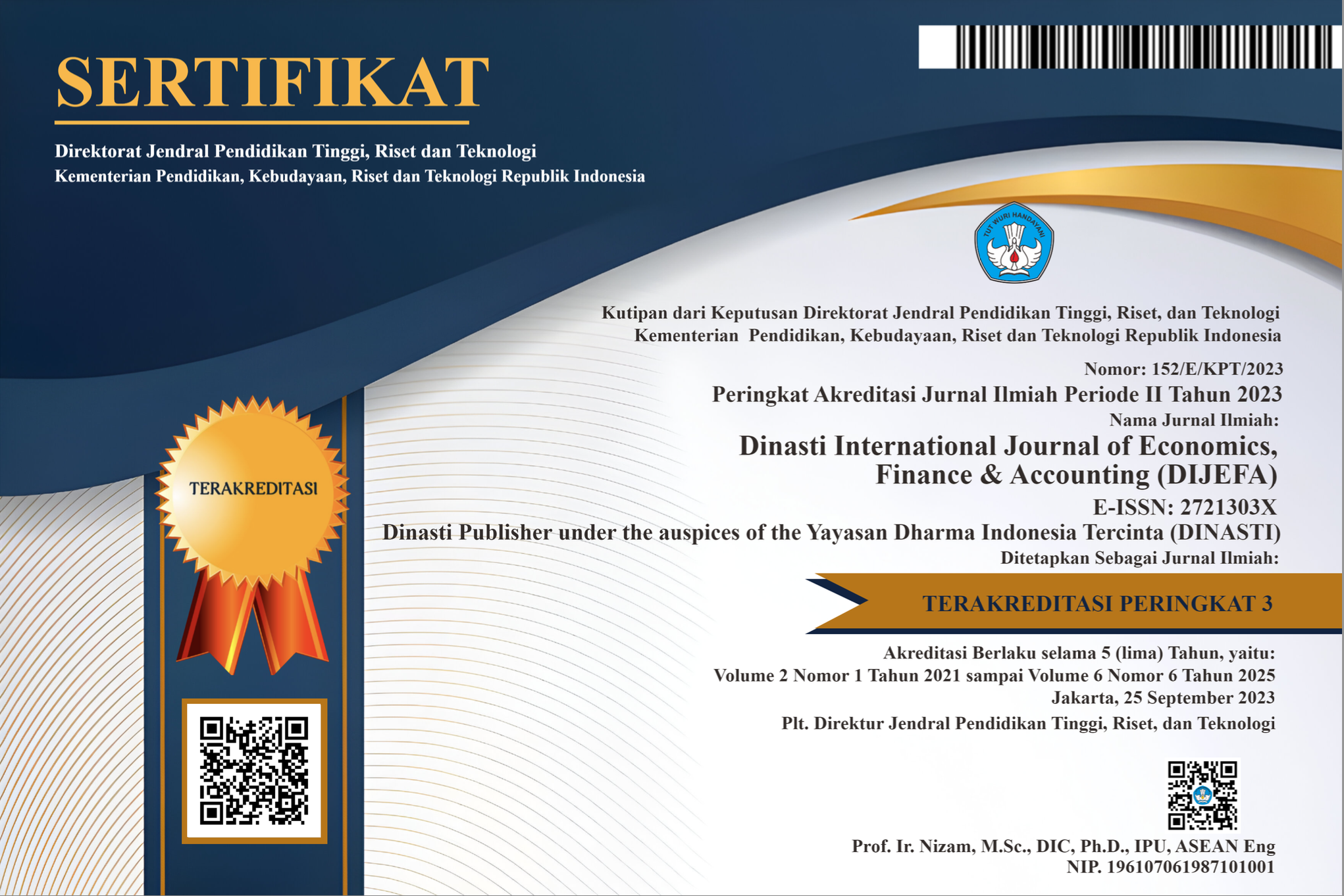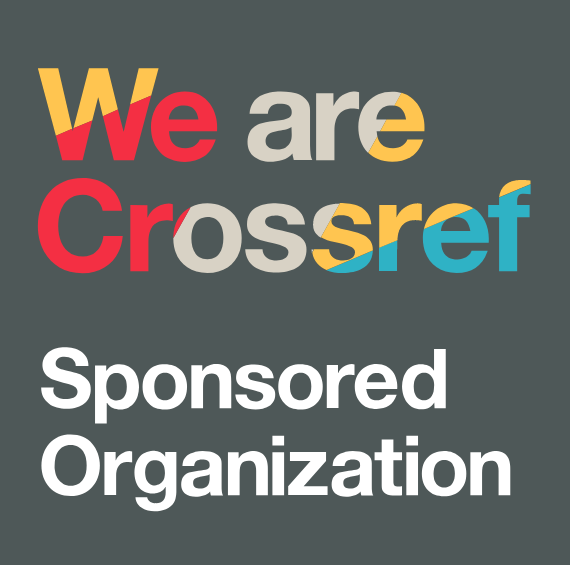Navigating Compliance: Regulatory Technology's Role in Anti-Money Laundering in Indonesia Banking
DOI:
https://doi.org/10.38035/dijefa.v5i4.3376Keywords:
regulatory technology, money laundering, preventing, bankingAbstract
The financial sector system is unlawfully used for money laundering, which causes massive losses for the state and country. An essential component of successfully combating money laundering is regulatory technology (RegTech). This study aims to investigate the impact of implementing Electronic Know Your Customer (e-KYC), transaction monitoring (TM), cost and time efficiencies (CTE), regulatory compliance (RC), and technology information infrastructure (ITI), in money laundering preventing (MLP) in the banking sector in Indonesia. A quantitative method is used to explore the interplay of variables. The research sample consists of 50 owners of BRI Link agents. Data analysis is conducted using a linear regression model. The study's findings underscore the significant influence of TM, CTE, RC, and ITI on the effectiveness of PML, with CTE emerging as the most influential driver. Despite a moderately positive correlation among these factors, the e-KYC provided by regulatory technology (RegTech) does not exert a substantial impact on MLP. The implications of this research suggest that the adoption of RegTech, positively contributes to MLP efforts in banking institutions, highlighting the importance of utilizing technology and regulations to enhance Anti Money Laundry (AML) measures.
References
Anagnostopoulos, I. (2018). Fintech and regtech: Impact on regulators and banks. Journal of Economics and Business, 100(1), 7–25. https://doi.org/https://doi.org/10.1016/j.jeconbus.2018.07.003
Arner, D. W., Barberis, J. N., & Buckley, R. (2018). RegTech: Building a Better Financial System. Handbook of Blockchain, Digital Finance, and Inclusion, 1(1), 359–373. https://doi.org/https://doi.org/10.1016/B978-0-12-810441-5.00016-6
Asmawanti, D., Sari, A. M., Fitranita, V., & Wijayanti, I. O. (2020). Dimensi Akuntabilitas Kinerja Instansi Pemerintah Daerah. Journal of Applied Accounting and Taxation, 5(1), 85–94. https://doi.org/10.30871/jaat.v5i1.1850
Bank for International Settlement. (2017). Basel Committee on Banking Supervision Consultative Document Sound Practices for the Management and Supervision of Operational Risk (Issue June).
Chen, Z., Le, D. V.-K., Teoh, E. N., & Nazir, A. (2018a). Machine learning techniques for anti-money laundering (AML) solutions in suspicious transaction detection: a review. Knowledge and Information Systems, 57(2), 245–285. https://doi.org/https://doi.org/10.1007/s10115-017-1144-z
Chen, Z., Le, D. V.-K., Teoh, E. N., & Nazir, A. (2018b). Machine learning techniques for anti-money laundering (AML) solutions in suspicious transaction detection: a review. Knowledge and Information Systems, 57(2), 245–285. https://doi.org/https://doi.org/10.1007/s10115-017-1144-z
Dewata, E., Sari, Y., Jauhari, H., & Lestari, T. D. (2020). Ketaatan pada Peraturan Perundangan, Sistem Pelaporan dan Akuntabilitas Kinerja Instansi Pemerintah. Jurnal Riset Akuntansi Dan Keuangan, 8(3), 541–550.
Duncan, P., Murphy, M., Man, M. S., Chaplin, K., Gaunt, D., & Salisbury, C. (2018a). Development and validation of the Multimorbidity Treatment Burden Questionnaire (MTBQ). BMJ Open, 8(4), 1–10. https://doi.org/10.1136/bmjopen-2017-019413
Duncan, P., Murphy, M., Man, M. S., Chaplin, K., Gaunt, D., & Salisbury, C. (2018b). Development and validation of the Multimorbidity Treatment Burden Questionnaire (MTBQ). BMJ Open, 8(4), 1–10. https://doi.org/10.1136/bmjopen-2017-019413
Farnham, K. (2023). Regulatory compliance 101: Definition, requirements & solutions. Diligent. https://www.diligent.com/resources/blog/what-is-regulatory-compliance
Fitria, N. I., Nurisnaini Putri, & Putri Zahrani. (2022). Literature Review Determinasi Infrastruktur Ti: Telekomunikasi, Internet Dan Brainware. Jurnal Manajemen Pendidikan Dan Ilmu Sosial, 3(2), 561–572. https://doi.org/10.38035/jmpis.v3i2.1119
Freij, Å. (2020). Using technology to support financial services regulatory compliance: current applications and future prospects of regtech. Journal of Investment Compliance, 21(2), 181–190. https://doi.org/https://doi.org/10.1108/joic-10-2020-0033
Karsh, S. A., & Abufara, Y. (2020). The New Era of Financial Technology in Banking Industry. Journal of Southwest Jiaotong University, 55(4). https://doi.org/10.35741/issn.0258-2724.55.4.54
Kurniawan, V. (2023). The Role of Regulatory Technology & Bankers to Prevent Money Laundering in Bank. JBMO Jurnal Bisnis, Manajemen, Dan Perbankan, 9(1), 43–52. https://doi.org/10.21070/jbmp.v9vi1.1660
Kurum, E. (2023). RegTech solutions and AML compliance: what future for financial crime? Journal of Financial Crime, 30(3), 776–794. https://doi.org/https://doi.org/10.1108/JFC-04-2020-0051
Lootsma, Y. J., & Brussels, I. (2017). From Fintech to Regtech: The possible use of Blockchain for KYC YVONNE. Static1.Squarespace.Com.
Machkour, B., & Abriane, A. (2020). Industry 4.0 and its implications for the financial sector. Procedia Computer Science, 177(1), 496–502. https://doi.org/10.1016/j.procs.2020.10.068
Miller, R. S., & Rosen, L. W. (2017). Anti-Money Laundering?: An Overview for Congress.
Mulya, H. G., & Fauzihardani, E. (2022). Pengaruh Kejelasan Sasaran Anggaran, Pengendalian Akuntansi dan Sistem Pelaporan terhadap Akuntabilitas Kinerja Instansi Pemerintah dengan Kepatuhan Terhadap Regulasi sebagai Variabel Pemoderasi. Jurnal Eksplorasi Akuntansi, 4(1), 192–212. https://doi.org/10.24036/jea.v4i1.463
Neuman, W. L. (2013). Social Research Methods: Qualitative and Quantitative Approaches (Seventh Ed). Pearson Education Limited.
Ofoeda, I., Agbloyor, L., & Abor, J. Y. (2024). Financial sector development, anti-money laundering regulations and economic growth. International Journal of Emerging Markets, 19(1), 191–210. https://doi.org/https://doi.org/10.1108/IJOEM-12-2021-1823
O’Reilly, M., & Khrisna, D. (2017a). Regulatory productivity: Is there an answer? (RegTech Position Paper).
O’Reilly, M., & Khrisna, D. (2017b). Regulatory productivity: Is there an answer? (RegTech Position Paper).
Perlman, L., & Gurung, N. (2019). Focus Note: The Use of eKYC for Customer Identity and Verification and AML. SSRN Electronic Journal, 1(1), 1–28. https://doi.org/10.2139/ssrn.3370665
Pramudya, D. A. (2023). IT Infrastructure. Binus University. https://sis.binus.ac.id/2023/01/10/it-infrastructure/
Repin, M., Mikhalsky, O., & Pshehotskaya, E. (2017). Architecture of Transaction Monitoring System of Central Banks Scenario Probabilistic Logic Models for Detecting Fraud Activity via Payment Systems of Central Banks. Advances in Engineering Research, 133(1), 654–658.
Rohma, F. F. (2023). Efektivitas Informasi dan Komunikasi dalam Memitigasi Tendensi Kecurangan Pengadaan Barang dan Jasa. Jurnal Akuntansi Dan Keuangan, 12(1), 1.
Savitri, S. I. (2021). IT Competency: Studi Adaptasi Kinerja Program Keluarga Harapan Pada Dinas Sosial Kabupaten Malang. Jurnal Bisnis Net, 4(1), 67–73.
Singh, C., Zhao, L., Lin, W., & Ye, Z. (2022). Can machine learning, as a RegTech compliance tool, lighten the regulatory burden for charitable organisations in the United Kingdom? Journal of Financial Crime, 29(1), 45–61. https://doi.org/https://doi.org/10.1108/JFC-06-2021-0131
Teichmann, F., Boticiu, S., & Sergi, B. S. (2022). RegTech - Potential Benefits and Challenges of Businesses. Technology in Society, 1(1). https://doi.org/https://doi.org/10.1016/j.techsoc.2022.102150
Turki, M., Hamdan, A., Cummings, R. T., Sarea, A., Karolak, M., & Anasweh, M. (2020). The regulatory technology “RegTech” and money laundering prevention in Islamic and conventional banking industry. Heliyon, 6(10), e04949. https://doi.org/10.1016/j.heliyon.2020.e04949
Wheeler, E. (2022). Regulatory Compliance, Security Risk Management: Building an Information Security Risk Management from the Ground Up. Syngress. Binus University. https://sis.binus.ac.id/2022/03/09/regulatory-compliance/
World Bank. (2021). Principles on Identification for Sustainable Development. World Bank Group.
Yang, Y.-P., & Tsang, C.-Y. (2018). RegTech and the New Era of Financial Regulators: Envisaging More Public-Private Partnership Models of Financial Regulators. University of Pennsylvania Journal of Business Law, 21(2), 354–404.
Yoland. (2023). Mengapa Regulatory Compliance Penting untuk Bisnis Anda? GRC Indonesia. https://grc-indonesia.com/mengapa-regulatory-compliance-penting-untuk-bisnis-anda/
Zabelina, O. A., Vasiliev, A. A., & Galushkin, S. V. (2018). Regulatory Technologies in the AML/CFT. KnE Social Sciences, 3(2), 394–401. https://doi.org/10.18502/kss.v3i2.1569
Downloads
Published
How to Cite
Issue
Section
License
Copyright (c) 2024 Ilham Gema Wibowo, Herlin Tundjung Setijaningsih

This work is licensed under a Creative Commons Attribution 4.0 International License.
Authors who publish their manuscripts in this journal agree to the following conditions:
- The copyright on each article belongs to the author(s).
- The author acknowledges that the Dinasti International Journal of Economics, Finance & Accounting (DIJEFA) has the right to be the first to publish with a Creative Commons Attribution 4.0 International license (Attribution 4.0 International (CC BY 4.0).
- Authors can submit articles separately, arrange for the non-exclusive distribution of manuscripts that have been published in this journal into other versions (e.g., sent to the author's institutional repository, publication into books, etc.), by acknowledging that the manuscript has been published for the first time in the Dinasti International Journal of Economics, Finance & Accounting (DIJEFA).


























































